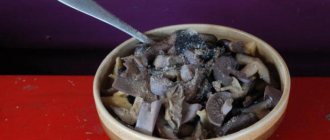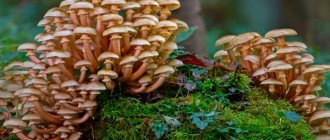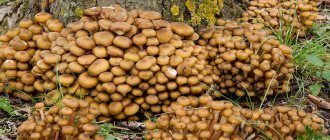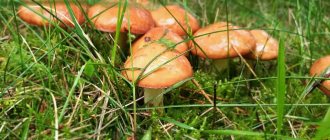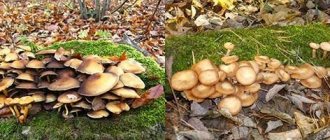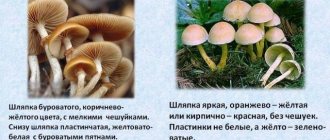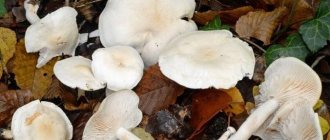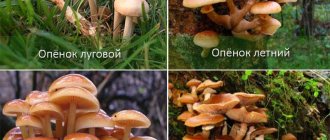Honey mushrooms are extremely popular among mushroom pickers, because they have a high taste when fried, salted or pickled. In addition, collecting them is beneficial from a practical point of view: if you find a large family of these mushrooms, you can easily fill an entire basket. In this case, there is a risk of confusing edible species with poisonous ones.
In order not to accidentally put false inedible honey mushrooms in your basket, you need to know the main signs by which they can be distinguished from edible ones. This article is dedicated to this topic.
Honey mushrooms, but not the same ones
False Honey mushrooms - little forest deceivers
Honey mushrooms are one of the most favorite search objects during a quiet hunt. There are many types of them, differing in places of growth, culinary value and nuances of appearance. We have already looked at what honey mushrooms look like in other articles. Honey mushrooms also have various doubles that are similar in appearance, but have no nutritional value, and are even completely poisonous. Among these doubles, a significant place is occupied by False Honey Mushrooms - this category includes a group of species, most often originating from the genus Hyfoloma, family Strophariaceae, or the genus Psatirella, family Dungweed.
Some types of False Honey Mushrooms are officially classified as conditionally edible mushrooms, but even if they can, theoretically, be eaten, there is no particular point in this.
During a quiet hunt for honey mushrooms, it is imperative to know and take into account the external signs of False Honey mushrooms, so as not to accidentally grab them instead of edible ones.
Types of False Honey mushrooms
Benefits - composition, vitamins and microelements, calorie content
The energy value of 100 g of summer mushrooms is very low, only 17-22 kcal, so they are included in all kinds of diets and consumed during fasting.
Nutritional value of 100 g of fresh summer mushrooms:
- water 90 g;
- proteins 2.3 g;
- fats 1.1 g;
- carbohydrates 0.6 g;
- dietary fiber 5.1 mg% (25.5 daily value).
Vitamins per 100 g:
- vitamin PP 10.3 mg% (53.5
- vitamin B1 0.11-1.45 mg% (31.2%);
- vitamin B2 0.2-0.4 mg% (22.7%);
- vitamin C 11.1 mg% (12.2%).
Minerals:
- potassium 400.0 mg% (16%);
- magnesium 20 mg% (5%);
- phosphorus 48 mg (6.0%);
- iron 0.78 mg (4.3%).
Microelements:
- copper 82-228 µg% (16.1%);
- nickel 47.0 µg% (31.2%);
- zinc 650-1470 µg% (9.1%);
- chromium 5.4-26.0 µg% (31.7%).
Honey mushrooms improve heart function and metabolism and inhibit the development of cancer cells.
Serno's false honey fungus – Yellow Hypholoma Fasciculare
False honey fungus Serno - Yellow Hypholoma Fasciculare
Poisonous mushroom, the most dangerous of the false honey mushrooms. Causes serious food poisoning if consumed.
Appearance
The cap is small, up to 7 cm in diameter, initially bell-shaped, later spread out. It is painted in sulfur-yellow, brown-yellow shades, always darker in the center.
The hymenophore is lamellar, the plates are thin and frequent, adherent to the stalk, in youth they are sulfur-yellow in color, subsequently darkening to greenish or olive-black. Spore powder is chocolate brown in color.
The leg is up to 10 cm long and up to 0.5 cm in diameter, fibrous and smooth, hollow inside, light yellow in color.
The pulp is white or light yellow in color, has an unpleasant odor and a pronounced bitter taste. Does not change color when cut.
Where and when does it grow
This species grows in large groups, very rarely alone, from late May to late autumn, on old stumps, rotting wood, on the ground near stumps and old trees. Occasionally found on the trunks of living trees. It prefers deciduous forests, but can also be found in coniferous forests.
Danger level
The toxins contained in the mushroom are not destroyed by heat treatment, and if they enter the human body, they cause severe food poisoning - vomiting, diarrhea, increased heart rate and sweating, up to loss of consciousness. Symptoms of poisoning can appear within an hour to six hours after eating mushrooms. No deaths have been recorded yet.
False honey fungus Serno - Yellow Hypholoma Fasciculare
The easiest one to confuse with this mushroom is the edible Honey fungus Hypholoma Capnoides , which is similar in appearance, but this species grows only in coniferous forests, and its hymenophore plates are gray in color.
Ripening season
The name of the culture we are considering speaks for itself. Summer honey mushrooms can be collected in the warm season, or more precisely, from May to September/October. In cold regions of the Russian Federation, the collection period can be reduced to two months (July - August). The ripening of fruiting bodies can begin with the first warming and last in several “waves”.
Since the Strophariaceae family is a parasitic plant, fungal mycelium appears on deciduous trees, fallen trunks and uprooted stumps, actively developing on dying wood. It happens much less often that honey mushroom families ripen in the grass.
Long-legged False Honeysuckle Hypholoma Elongatum
False honey fungus Long-legged Hypholoma Elongatum
A poisonous mushroom that also causes food poisoning, but is less dangerous for gatherers, since it bears little resemblance to edible species. Also known as Hytholoma elongata.
Appearance
The cap is small, up to 3.5 cm in diameter, initially hemispherical, then flat, mucous in wet weather. The color of the cap, as it ripens, changes from yellow, ocher to olive. In young specimens, fragments of the veil may remain on the cap.
The hymenophore is lamellar, the plates are frequent and free, sometimes shortened, have a gray-yellow tint, the spore powder is brown.
The leg is thin and slender, fragile, fine-fibered, up to 12 cm long, and up to half a centimeter thick. May be slightly curved. It is painted in a light yellow shade on top, turning into brownish-red tones below. The surface of the leg is covered with small elongated scales.
The pulp is thin and fragile, yellowish in color, which does not change when cut. It has a bitter taste and a distinctly unpleasant odor.
Where and when does it grow
This species loves acidic soils and damp, wetlands, moss-covered areas. Grows in coniferous and mixed forests from late spring to late autumn. Fruits in groups and singly. In Russia it is found throughout the temperate forest zone.
Danger level
The nature of the toxins contained in this mushroom is still little studied, but it is known that eating it causes food poisoning.
Fortunately, this species does not have a strong resemblance to edible honey mushroom species.
Varieties
Other types of these mushrooms also grow in Russia:
- Honey fungus, or meadow marasmius. Its colonies can be seen in open areas: meadows, ditches, forest edges, near dachas and country houses. Signs of this species are a thin stem and a small cream-colored cap.
Honey fungus. - Udemanciella mucosa. A distinctive feature of this variety is its flat-convex olive-gray cap, covered with whitish or yellowish mucus. The pulp is tasteless and odorless. Udemansiella's favorite habitat is the trunk of a diseased or fallen beech tree.
Udemanciella mucosa. - Honey fungus thick-legged grows on fallen leaves, rotten stumps of ash, fir, and beech. It can be recognized by its thick and dense stem. It, like the brown cap, is covered with brown scales. The taste of the mushroom is cheesy, slightly astringent.
Thick-legged honey fungus.
In addition to summer ones, there are autumn and winter honey mushrooms. The former can be found in the forests of Russia in August - November, the latter - in November - April.
Moss honey fungus Hypholoma Polytrichi
Moss honey fungus Hypholoma Polytrichi
This species is also poisonous and is very similar in appearance to Long-legged false honey fungus in appearance and habitat.
Appearance
The cap is up to 3.5 cm in diameter, hemispherical in young fruiting bodies and prostrate in mature fruiting bodies. The cap is colored brown, sometimes with a slightly olive tint, with lighter edges. In young specimens, remnants of the veil are often visible on the cap, and in damp weather it becomes slimy.
The hymenophore is lamellar, the plates are grayish-yellow in color. The spore powder is brownish.
The leg is straight and thin, up to 12 cm long and up to 4 mm thick. It has a brownish-olive or yellow-brown tint. In young specimens, thin fibers are visible on the stalk.
The pulp is light, thin, with a weak taste and smell.
Where and when does it grow
Grows from early summer to mid-autumn, in mosses, in damp wetlands, in all types of forests.
Danger level
The mushroom is still poorly studied; whether it is seriously dangerous or not is currently unknown, but officially it is classified as definitely poisonous. When consumed, it causes food poisoning - nausea and vomiting, difficulty breathing, numbness of the limbs.
Psathyrella Piluliformis
False Honey mushrooms are small forest deceivers.
An inedible mushroom from the genus Psatirella, family Psatirella. Also known as Watery False Foam.
Appearance
The cap, up to six centimeters in diameter, is convex, hemispherical or bell-shaped in youth, but becomes semi-prostrate with age. The color of the cap depends greatly on the weather - from chocolate in the rainy season to cream in dry weather. Remnants of the bedspread are often visible along the edges of the cap.
The hymenophores are lamellar, the plates are adherent, frequent, light in young specimens and dark brown in mature specimens. In wet weather, droplets of liquid may be released from them. Spore powder is violet-brown.
The leg is hollow and dense, up to 8 cm high and up to 0.7 cm in diameter, it can be straight or curved, its surface is silky and smooth. There is a ring on the stem, above which the stem is often covered with a powdery coating; in the lower part it is light brown in color.
The pulp is quite hard, creamy in color, without a pronounced smell or taste.
Where and when does it grow
Grows from early June to mid-October on stumps, wood debris, on damp soils, in coniferous and mixed forests. Fruits in large groups, often forming clusters.
Danger level
The mushroom is considered inedible, but there are known cases of its consumption after a long soaking and preliminary boiling. Some even think it's quite tasty.
Degree of similarity
False Honey Fungus - small forest deceivers
This species can be confused with the Summer Honey Mushroom due to the similar color of the cap, but the edible honey mushroom is larger and grows mainly in deciduous forests.
By what criteria do they differ?
If you want to collect exclusively edible honey mushrooms in the forest and avoid inedible ones, be careful. It is important to know how to distinguish false mushrooms from edible ones:
- smell. Fruit bodies suitable for consumption are characterized by a rich, pleasant aroma. False hens will smell like rotten soil;
- the original ones have a “skirt” located between the stem and the cap. In false foam there is no such “decoration”;
- shades of plates. Sun-cream plates are useful. And in false ones, the plates are colored olive or light brown;
- outer part of the cap. The original ones have a cap, which is characterized by the presence of a small number of scales. Dangerous doubles have a smooth surface;
- shade. If the useful types of honey mushrooms are suitable for consumption, they will have a light brown color. Imitators are characterized by a gray or brick tint.
Honey fungus Brick-Red Hypholoma lateritium
Honey fungus Brick-Red Hypholoma lateritium
Conventionally - an edible mushroom, suitable for food after preliminary boiling. Also known as False foam brick red.
Appearance
The cap is up to 8–12 cm in diameter, convex in young specimens and almost flat in mature ones. The skin of the cap is smooth and dry, its color varies from pinkish ocher to brick red, with a darker center and light edges. In young specimens, the cap threads may be visible.
The hymenophore is lamellar, the plates are narrow, thin and often evenly adherent, or with a small notch. Cream-colored in young ones, and purple-gray in mature specimens. The sor powder is violet-brown.
The leg is up to 12 cm long and up to 2 cm thick, smooth or slightly curved, solid in youth, hollow inside in mature specimens. It is colored yellowish-white in the upper part, and light brown shades in the lower part. There is no ring on the leg.
The pulp is dense, light, with a faint mushroom odor and bitter taste.
Where and when does it grow
It grows from the end of June until the very beginning of winter, on rotting deciduous wood, especially preferring oak. Sometimes it can also be found on coniferous trees.
Danger level
The mushroom is known to contain toxins and can cause food poisoning if eaten raw. It is recommended to boil this mushroom three times before use, for 20 minutes each, with the obligatory draining of the broth. After processing, this mushroom is suitable for pickling or frying.
Mr. Summer Resident recommends: How to distinguish false honey mushrooms from edible ones?
| Indicators | Autumn honey fungus | Seroplate | Brick red | Sulfur yellow |
| Leg | Beige, with cuff | Light yellow, reddish-brown below, without a ring | Bright yellow above, brown below, without a ring | Light yellow, without ring |
| hat | Beige-pink | Yellow or brown | Brick red | Sulfur yellow |
| Records | Light brown | Gray | Gray | Yellow |
| Taste | Mushroom | Weak | Bitterish | Bitter |
| Smell | Mushroom | Unpleasant | Unpleasant | Unpleasant |
| Reaction to contact with water | The edges of the cap become transparent | No | No | No |
| Edibility | Edible | Edible | Conditionally edible | Poisonous |
In case of poisoning
False mushrooms are not as dangerous as Pale Toadstool or Galerina Bordered. Fortunately, there is no information that anyone was poisoned to death by false honey mushrooms. However, there is little good in the food intoxication they cause. In case of poisoning with false honey mushrooms, you must follow the basic rules for helping with mushroom poisoning:
- Rinse the patient's stomach with boiled water and soda (1 teaspoon per liter of water). The patient drinks a large volume of liquid, and then vomits by pressing on the root of the tongue. The procedure must be repeated until the water becomes clear.
- Give the patient activated charcoal.
- Lay the patient horizontally and wrap him warmly.
- After gastric lavage, provide the patient with plenty of fluids.
In case of severe poisoning, it is imperative to call an ambulance for the poisoned person.
False honey mushrooms are called that because they are similar to the real ones in their place of residence - on stumps and rotting wood, as well as external signs, but do not have their culinary qualities, and are sometimes dangerous to health.
Among the false mushrooms, there are no deadly poisonous ones, but there is little benefit from getting to know them, so it is useful for any collector to know what they look like and how they differ from normal mushrooms.
